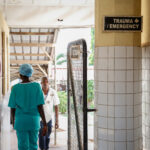- In South Africa, about one in four people with serious mental health conditions also have HIV, research shows.
- A new analysis makes a case for these patients to be added to the country’s list of key populations, who get special attention to help them access HIV services.
- Teaching these patients about safe sex and helping them to get tested and treated while they go to a clinic for other medical services can help — not only to get HIV infection numbers down but also to keep these patients healthy.
A new analysis estimates that there are about 645 000 people — about 1.5% of South Africa’s adult population — who have serious mental conditions such as schizophrenia, bipolar disorder and psychosis (this describes conditions in which patients’ perception of the world around them is not real). One in four people with mental illness like these have HIV.
This, researchers say, makes a good case for them to be added as a key population in the country’s current five-year plan (for 2023–2028) to deal with HIV infections, diagnosis and treatment, and so help us meet the United Nations targets to end the HIV epidemic by 2030.
“Key populations” are groups of people who have a bigger chance than the general population of getting HIV or needing treatment because of risky behaviour such as sharing needles for injecting drugs or being discriminated against for their gender or sexuality and therefore not being able to access the health services they need. For these reasons health authorities worldwide — and also in South Africa — focus on people who inject drugs, sex workers, transgender people, prisoners and men who have sex with men.
Countries can also focus on specific groups of people in their population who may have a bigger chance of getting the virus, even if these groups are not seen as a key population everywhere else in the world. In Africa, including in South Africa, teen girls and young women are one such group as they contract HIV faster than the general population — and their male peers — and make up more than two-thirds of all new global infections.
But many people with serious psychological illnesses who are HIV positive die because they don’t get — or stay — on treatment, and so the amount of virus in their bodies can’t be kept at low enough levels to keep them healthy.
Mental health conditions are called severe when they last for someone’s entire life and make it hard for them to care for themselves and do ordinary things like speaking clearly, eating or bathing. These conditions often go along with behaviours such as unpredictable agitation, inappropriate emotional reactions or unexpected silliness, hallucination, as well as depression and anxiety. (This is different from common mental health disorders, which are often only temporary and can clear up after time and with therapy.)
People with psychological issues like these are often discriminated against in the sense that they are seen as “dysfunctional” so they frequently don’t get help at health facilities or they could be victimised by others, which could expose them to HIV infection. At the same time, they have little access to treatment, which makes them a high-risk group, says Melvyn Freeman, a psychologist and researcher at the Foundation for Professional Development and one of the authors of the new paper.
Becoming a key population group in HIV policy can change this, he says.
We take a look at what this could mean for South Africa’s efforts to keep the country’s 95-95-95 targets on track. (The 95-95-95 targets are United Nations goals to which member countries such as South Africa subscribe, set to end HIV as a public health threat by 2030. The aim is that by 2025, 95% of people living with HIV should know their status, 95% of people who have been diagnosed with HIV should be on treatment and 95% of those on medication should have so little HIV in their blood that they can’t transmit the virus to someone through sex).
Stigma, discrimination and little services
Globally, key populations accounted for almost two-thirds of new HIV infections in 2020.
To decide on these groups in South Africa, the national Aids council (Sanac) looks at data on HIV prevalence and meets with community organisations around the country “to hear their voices”, says Nelson Dlamini, spokesperson for Sanac.
After such consultations, a team of experts discuss what could be stopping these groups from getting tested or treated, and propose solutions. For example, in the latest HIV plan one of the goals aims to decriminalise sex work, because when working legally these workers are more likely to test for HIV and get treated if they’re infected.
The focus on mental health has grown in South Africa’s HIV plans, with the latest edition listing people with mental disorders as a priority population, which means they are recognised as needing special attention when it comes to HIV services, and so funds can be allocated to bolster healthcare for them.
Yet, focusing specifically on people with severe mental health conditions as a key population would be simpler, as it is easier to determine the prevalence of HIV infections in a smaller group. (Knowing how many people are likely to have HIV in a group is one of the requirements for them to be recognised as a key population.)
But funding to increase access to HIV services for priority groups is not as focused as it is for key populations, who are recognised internationally and so are “regarded as [having] higher precedence than priority populations,” says Freeman.
Funding usually comes from the government, together with international donors like The Global Fund to Fight Aids, Tuberculosis and Malaria, USAID (the United States Agency for International Development), and Pepfar, the US President’s Emergency Plan for Aids Relief.
Stigma can also make it hard for people with serious mental illnesses to access HIV services.
Last year, a commission set up by The Lancet to look at stigma and discrimination in mental health found that prejudice from healthcare staff lowers the quality of treatment people with mental disorders get, which makes them less likely to want to go to a hospital or clinic. In some cases, patients who need help for physical symptoms are told that they’re a side effect of their mental condition.
And when people do actually go to a healthcare facility for medical help, they’re often only treated for their mental health needs — rather than for things like general health checkups or HIV testing. “All they [healthcare workers] see them as are mental patients,” says Freeman.
In a small 2008 study at a public psychiatric hospital in the Western Cape, researchers interviewed psychiatrists after they found that no more than one in every seven patients who were admitted to the facility were tested for HIV.
Doctors said that they didn’t perform HIV tests on these patients routinely because many aren’t well enough to give their permission and that because the hospital didn’t have much access to antiretrovirals, they wouldn’t be able to treat them anyway, so testing was pointless.
Mental health and risky sex
Mental health disorders are common in South Africa.
In a national survey on these conditions across respondents, about a quarter were found to have reported symptoms of a mild mental health problem such as depression or anxiety. Although less than 2% reported having a severe disorder, in poor countries about 80% of patients with such conditions don’t get the right care.
People with severe psychiatric conditions can have symptoms like low impulse control, impaired judgement or increased sexual activity during periods of psychosis. Studies from South Africa have found that between 24% and 40% of people in this group have HIV.
Psychiatric patients are often assumed to not have sex and sexual activity is generally prohibited in facilities. But while people with serious mental illnesses have less sex than the general population, they tend to have riskier sex.
Researchers interviewed patients at a psychiatric facility in Nigeria and found that those who were having sex tended to not use condoms or engaged in sex work.
While people with severe mental health conditions may also fall under other key groups like sex workers or people who inject drugs, Freeman says that treatment then focuses only on HIV and not their mental health condition too.
As one US study showed, people with severe conditions noted that when they had active mental illness, other aspects of their healthcare were ignored, which led to them missing their appointments for getting HIV treatment.
‘A step in making something of substance happen’
There aren’t any international guidelines on treating both HIV and severe mental health conditions, but the Global Aids Strategy (2021–2026) aims to have these services integrated by 2026. The document is a five-year plan to reduce the Aids burden by focusing on groups that can’t access HIV services because of inequalities, such as by training health workers to be more sensitive in their service so that they don’t further stigma.
Researchers in South Africa already recommend combining HIV and mental health services, such as screening and testing for HIV when people go to a facility for their mental health needs. If people with serious psychiatric disorders could become a key population, it would be a big step in raising awareness about the issues that prevent them from getting HIV care and how to solve those problems, says Freeman.
As a start, all new patients admitted to psychiatric facilities should be tested for HIV, and the risks and benefits of this to them should be explained. HIV and STI testing has become more regular in centres that offer treatment for mental health, a study published in the South African Journal of Psychiatry in January showed, but the number of people living with HIV in this group is still almost double that of the general population, earlier research found.
Sex education with refresher sessions can help patients who have trouble learning or concentrating. Studies have shown that when patients attended learning sessions in which content was repeated, their number of sex partners dropped and their use of condoms increased. However, none of the studies showed that what had been learned lasted for more than six months, which suggests that following up with refresher courses is necessary.
People with severe mental conditions may also struggle to keep taking their ARVs. Using pre-exposure prophylaxis, also known as PrEP, in this group in community mental health clinics can help.
PrEP are medicines that can prevent someone from contracting HIV, such as the daily HIV prevention pill, which was rolled out in South Africa in 2016. (By May, about one million people in the country have started using the pill.)
Advocacy can play a big role too. At one hospital in the US, staff encouraging in-patient HIV testing and counselling led to more than triple the number of people getting tested than before. Health workers at the centre were also taught — by someone they chose — why early testing and getting started on ARVs soon after diagnosis was important.
Francois Venter, is an HIV doctor who has worked with his patients for more than 20 years and the director of Ezintsha at the University of the Witwatersrand. From his patients’ experiences he’s seen clearly how mental health and HIV infection connect and says that although mental health gets spoken about a lot it’s an area where patients get little practical help.
About making people with serious mental illness a key population, Venter concludes: “This would be a step towards making something of substance happen.”
Zano Kunene is a health journalist at Bhekisisa.








